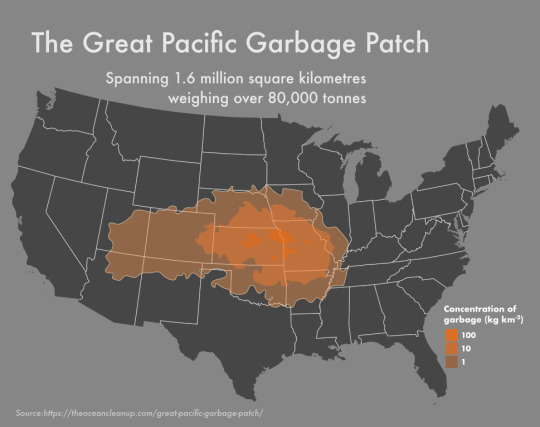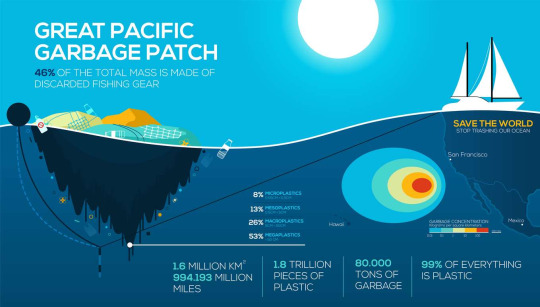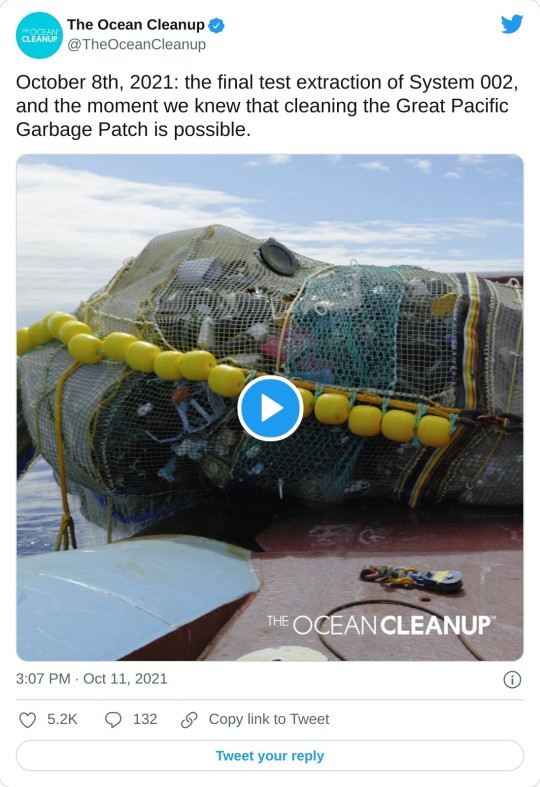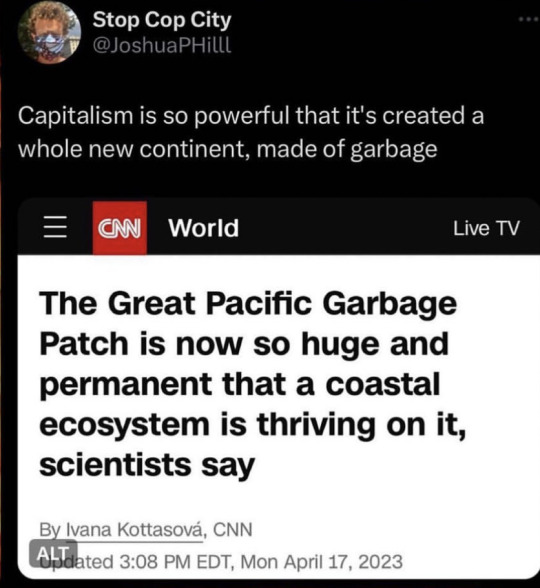#great pacific garbage patch
Link
““The Great Pacific Garbage Patch can now be cleaned,” announced Dutch entrepreneur Boyan Slat, the wonderkid inventor who’s spent a decade inventing systems for waterborne litter collection.
Recent tests on his Ocean Cleanup rig called System 002, invented to tackle the 1.8 trillion pieces of plastic pollution, were a success, leading Slat to predict that most of the oceanic garbage patches could be removed by 2040.
Intersections of ocean currents have created the massive floating islands of plastic trash—five slow-moving whirlpools that pull litter from thousands of miles away into a single radius.
The largest one sits between California and Hawaii, and 27-year-old Slat has been designing and testing his systems out there, launching from San Francisco since 2013.
GNN has reported on his original design for the floating device, but his engineering team improved upon it. System 002, nicknamed “Jenny,” successfully netted 9,000 kilograms, or around 20,000 pounds in its first trial.
It’s carbon-neutral, able to capture microplastics as small as 1 millimeter in diameter, and was designed to pose absolutely no threat to wildlife thanks to its wide capture area, slow motion, alerts, and camera monitors that allow operators to spy any overly-curious marine life...
Slat estimates ten Jennies could clean half the garbage patch in five years, and if 10 Jennies were deployed to the five major ocean gyres, then 90% of all floating plastic could be removed by 2040.” -via Good News Network, 10/19/21
#great pacific garbage patch#pacific ocean#pollution#plastic#plastic waste#dutch#california#hawaii#microplastic#good news#hope
76K notes
·
View notes
Link
The Ocean Cleanup, the only organization currently tackling the Great Pacific Garbage Patch (GPGP), has just reached a milestone of 200,000 kilograms, or 220 tons of plastic removed from the ocean.
In recent years, the Dutch non-profit completed the test run of their new system 002/B which can capture multiple tons of garbage in one sequence with its large booms measuring a mile and a half in length
The GPGP is not so much an island as it is an area where major currents and winds have brought together trillions of pieces of plastic.
By using the data of the currents and the winds to estimate volumes of plastic and to guide the capture vessels, Bojan Slat, the CEO and Founder of Ocean Cleanup, believes he can clean the whole patch in just a decade.
From Good News Network
#great pacific garbage patch#pollution#plastic pollution#plastic#ocean restoration#ocean conservation#good news#hope#environment#environmental grief#ecoanxiety#ecogrief
1K notes
·
View notes
Video
3K notes
·
View notes
Photo

What the great pacific garbage patch looks like layer over the USA
577 notes
·
View notes
Photo


NORTH PACIFIC GYRE NOW WORKS AS A ISLAND, WHERE COASTAL SPECIES CAN THRIVE
Researchers have recently prove that the high seas are colonized by a diverse array of coastal species, which survive and reproduce in the Great Pacific Garbage Patch, a collection of floating marine debris in the North Pacific Ocean, in the open ocean.
Researchers examined 105 items of floating plastic items collected from the Great Pacific Garbage Patch, and identified 484 marine invertebrate organisms on the debris, accounting for 46 different species, of which 37 coastal were invertebrate species from coastal habitats, largely of Western Pacific origin. Most of these coastal species possessed either direct development or asexual reproduction, possibly facilitating long-term persistence on rafts.
The Great Pacific Garbage Patch is so huge that the findings suggest plastic pollution in the ocean might be enabling the creation of new floating ecosystems of species that are not normally able to survive in the open ocean.
These emergent properties of plastic rafts may play an important role in sustaining diverse biofouling communities, but more research is needed to understand how such emergent properties may drive colonization, succession and trophic interactions of coastal and pelagic taxa associated with floating plastics.
Photo above: Floating plastic debris from the the Eastern North Pacific Subtropical Gyre showing coastal organism living on. Photos courtesy of The Ocean Cleanup.
Photo below: Graphic of the debris collection sites, illustrated as diamonds, in the Eastern North Pacific Ocean Subtropical Gyre. Model of the predicted concentration of debris, the more red, the most you could find marine debris.
Reference (Open Access): Haram et al. 2023 Extent and reproduction of coastal species on plastic debris in the North Pacific Subtropical Gyre. Nat Ecol Evol
#plastic debris#marine pollution#north pacific subtropical gyre#5 gyres#great pacific garbage patch#pacific ocean#science#scienceblr#sciblr#marine science#marine biology#biology#bioblr#bio
305 notes
·
View notes
Text
What's up with all the plastic in the ocean?

Let me talk about one really sad thing - and one where the information out there is just really bad.
A lot of you will have heard about the Great Pacific Garbage Patch. And about how you should not use plastic straws and have to recycle all the plastic you use and what not, because it is killing all the poor animals and what not.
I am here to tell you... it's all a lie. All of it.
Now, let me first say: Recycling is a scam. Because of capitalism. Yes, we could recycle at least some of the plastics we use (not all of them), but for the most part we do not do that, because it just is too expensive. So most of the plastics you and I put into recycling end up in landfills... Most likely in landfills in poor nations, where the stuff gets shipped off to. We do not really do anything good with the recycling stuff. Because making new plastics is cheaper. Simple as that. Capitalism prefers the cheap stuff. So, recycling is not happening.
But also... that plastic usually is still not the biggest problem when it comes to plastic in the ocean. Like, that landfil plastics are a problem and they should not be there. But they are not the reason for the plastics in the ocean.
Now, let me first talk microplastics, even though they are off course not that much of the plastic in volume. But where does that microplastic come from? Media wants you to believe that it is just not-recycled plastic that has somehow been made small by the ocean... But that's not it.
Instead most of the microplastics come from cars. It is abrasions from tires and breaks, that collect on the roads and then through rain get slowly transported into the oceans.
But as you can see from the graph above: Most plastics in the oceans are actually macroplastics and megaplastics. So big pieces of plastic. So, what are those?
Mostly... Fishing waste. So, fishing nets, fishing lines and stuff like that, that after use get just thrown into the oceans. This is because the fishing industry is among the industries least regulated - for the simple fact that most industries that work off the ocean are hard to regulate. And of course in the end people are very unintrested in regulating such industries.
Which is also the reason for other stuff. Overfishing. Bycatch. All those things. It just is not properly regulated - and even what regulations are there are hard to enforce because... well, who is gonna enforce them out there.
So... really. To save the oceans... we gotta eat less fish.
#solarpunk#save the oceans#microplastics#great pacific garbage patch#oceans#environmentalism#save the planet
96 notes
·
View notes
Text
#good news#nature#science#environmentalism#environment#great pacific garbage patch#trash clean up#plastic pollution#ocean#pacific ocean
90 notes
·
View notes
Text
The optimist in me says that this is a great development, and I'm really hoping it passes. However, as a citizen of one of the very few UN Nations opposed to this treaty--the US--I'm very well aware of how both government and industry here are prone to dig their heels in when anyone suggests anything other than profit as the primary motivator to do, well, anything.
The good news is there are plenty of us here in the US and other opposing countries who are very much in favor of reducing plastic pollution. And while putting pressure on our elected officials isn't always an absolute guarantee they'll listen, it's better than sitting back on our thumbs and doing nothing. If nothing else, it shows the rest of the world that not all of us are only concerned with money.
By the way, industry's supposed solution of "just recycle it" doesn't work. We've tried that for decades, and the vast majority of plastic hasn't ended up recycled, instead going to landfills, getting tossed out of various car windows, getting incinerated, or shipped overseas where it is either put in landfills there, or simply dumped into the ocean. There is no streamlined, cost-effective way to sort and clean plastics, and it's much cheaper to just manufacture new plastics. It's pretty obvious we need a better solution, and the one that's going to be most effective is going to be--less plastic in the first place.
If you have an hour, here's a really great PBS Newshour segment on The Plastic Problem that goes into a lot more detail about all of the above.
#plastic#plastics#plastic pollution#pollution#Great Pacific Garbage Patch#garbage#trash#environment#conservation#nature#environmentalism
80 notes
·
View notes
Text

186 notes
·
View notes
Text

342 notes
·
View notes
Text
It's been a minute since I talked about a game, so I wanted to talk Trash... Land.
Trashland. It's a game I made.
Trashland is a hack of Down We Go, from Plus One EXP and Markus Linderum. It's set on the Great Pacific Garbage Patch after a climate event melts the polar ice caps most of humanity lives on boats or garbage piles, scrounging off of fish they can catch and anything they can find in the piles of garbage.
Admittedly, because I haven't played a ton of DWG, Trashland is mostly a reskin of that game's moves with my custom setting elements and a mechanic for finding random garbage. It's also the first time I set out to make a two-page RPG and actually succeeded!
I did create a small dungeon to go with it, based around the USS Constitution floating past, and dealing with a faction split among its crew. I had some plans to make a mall in a blimp, and create a dungeon based on SkyMall, but haven't had the time to go back.
But really, I kinda want to talk about the Hugo-nominated novella The Past is Red, by Catherynne Valenti which the game is based on.
The Past is Red is a fantastic piece of fiction that follows The Luckist Person in the World, Tetley Abednego, as she grows up on the Great Pacific Garbage Patch. It's bittersweet, as she finds love, learns of loss, and uncovers a greater truth about the human race.
I think about it a lot, because *gestures broadly at the world*. I definitely don't want to live on the Garbage Patch, but Tetley is content there. In part because she doesn't know any better, but in part because she's a fighter.
It contains that bittersweet hopepunk aspect that I like in my Post-Apocalyptic fiction. I appreciate that people are resilient, but also always feel strongly for what our generation (in the context of those stories) robbed them of.
If you liked the book, I hope you'd also like the game. But if you have to pick one, I think Valenti's book does more than I could do in 4 pages (plus a supplemental dungeon!)
#catherynne m. valente#the past is red#indie ttrpg#ttrpg dev#scifi rpg#post apocalypse#great pacific garbage patch#down we go#plus one exp#understory games
33 notes
·
View notes
Link
SYSTEM 002 IN 2022
“We captured our first plastic from the [Great Pacific Garbage Patch] in 2019 with [our ship] System 001/B, and since then we’ve been refining our steering strategy and deepening our understanding of plastic behavior in the oceans.
In 2021 we introduced System 002, and having now demonstrated that our system can consistently harvest significant amounts of plastic, we’re currently in transition to System 03 – our largest and most efficient cleanup system so far.
After demonstrating Proof of Technology the previous year, 2022 was all about cleaning. It was a successful year for The Ocean Cleanup in the GPGP:
System 002: 2022 in numbers
8 trips into the GPGP on cleaning operations
Over 150 days at sea (including transit)
153,000 kg of plastic removed from the GPGP in 2022
4 consecutive trips with catch totals over 25,000 kg
99.9% of catch comprising only plastic
The continuity of cleaning operations during this transition was essential in demonstrating that we are moving towards our efficiency targets and progressing our plan for scale-up. Significant milestones such as the extraction that brought us over the 100,000 kg barrier in the GPGP are documented and shared with our growing community of supporters worldwide, aiding the visibility of our mission and highlighting the urgency of the plastic pollution problem...
PRIORITIZING THE MARINE ENVIRONMENT
We are committed to maximizing our net positive impact on the marine environment. In that light, we place particular importance on one particular figure from our 2022 data: 99.9%. This is the amount of our total catch that consists of plastic, leaving a level of bycatch of 0.1%.
While this is not perfect and we are working hard to reduce it further, we believe this data shows that our mitigation measures and animal protection procedures are working effectively so far. We have also seen a reduction in bycatch rates during the year (see our January 2022 mid-term evaluation) as we implement new learnings and modifications.
Our environmental performance is a result of the measures we have taken since we began our ocean operations. Our systems move very slowly, meaning fish and marine animals can easily swim away, and our crew always has the option of triggering the emergency release to free any animal which has become trapped in the Retention Zone; although this results in the loss of any plastic which has been captured, we keep this option available for any serious encounters.
Upgrades to be implemented during the transition to System 03 include more underwater cameras to allow us to more closely monitor encounters with marine life, and increasing the number of openings throughout the system to allow animals to swim out. We will also be trialing various new deterrent and mitigation measures during 2023, working with our in-house and third-party marine biologists to ensure that we continue to reduce any type of bycatch to the minimal level possible.”
-via The Ocean Cleanup, 12/15/22
#ocean#pacific ocean#great pacific garbage patch#ocean cleanup#pollution#plastic pollution#2022#environment#good news#hope#sorry for all the denseness and jargon#the ocean cleanup is weirdly bad at really basic marketing techniques#like write your articles at a 9th grade-ish reading level#and "have a page dedicated to press about your nonprofit on your website#and I am not in the mood to write a custom post explainer lol
724 notes
·
View notes
Text

Story
12 notes
·
View notes
Text
A project to clean up the Great Pacific garbage patch reached a milestone, the global tiger population stabilised, and Botswana was hailed for its HIV success, plus more positive news
The great garbage patch cleanup hit a milestone
It has become emblematic of our throwaway society, a grim testament to the pitfalls of single-use plastic. But this week, efforts to clean up the Great Pacific garbage patch reached a milestone: 100,000kg of plastic removed so far.
Admittedly, it’s small fry. Strewn across an area twice the size of Texas, the floating mass of rubbish is 1,000 times larger than what has been landed so far. But the Dutch nonprofit behind the project, The Ocean Cleanup, said it was preparing to scale up.
“We are ready to move on to our new and expanded system, which is expected to capture plastic at a rate potentially 10 times higher,” said Boyan Slat, its CEO.
The Ocean Cleanup uses computer modelling to predict where large concentrations of rubbish will accumulate, and skims it from the sea using giant booms. The nonprofit deploys similar technology at river mouths to stop plastic entering oceans in the first place.
Image: The Ocean Cleanup
Read more...
#Environment#Health#Politics#Society#positive news#positive.news#Great Pacific garbage patch#the ocean cleanup#plastic capture#plastic pollution#cornwall#botswana#unaids#fighting HIV#tiger#tigers#cheetah#slovenia#same-sex marriage#toyota#cargo bikes#Seagreen wind farm#scotland#wind power#body positivity#scallops#good news
33 notes
·
View notes
Photo

The Size and Location of the Great Pacific Garbage Patch.
by u/NoComplaint1281
332 notes
·
View notes
Quote
According to The Ocean Cleanup, the Great Pacific Garbage Patch covers an estimated surface area of about 620,000 square miles, an area twice the size of Texas or three times the size of France. Scientists conducted the most elaborate sampling method ever coordinated to get that number. They consisted of a fleet of 62 boats, 652 surface nets and two flights over the patch to gather aerial images of the debris. A gyre binds together the floating piles of plastic and debris. According to NOAA’s National Ocean Service (NOS), a gyre is an extensive system of rotating ocean currents driven by wind, tides, differences in temperature and the salinity of the ocean. Those currents pull the plastic and trash toward the center and trap it there.
Steve Yablonski, ‘Great Pacific Garbage Patch now thriving with marine life, study says‘, Fox Weather
#Fox Weather#Steve Yablonski#The Ocean Cleanup#Great Pacific Garbage Patch#gyre#NOAA#National Ocean Service#NOS
6 notes
·
View notes